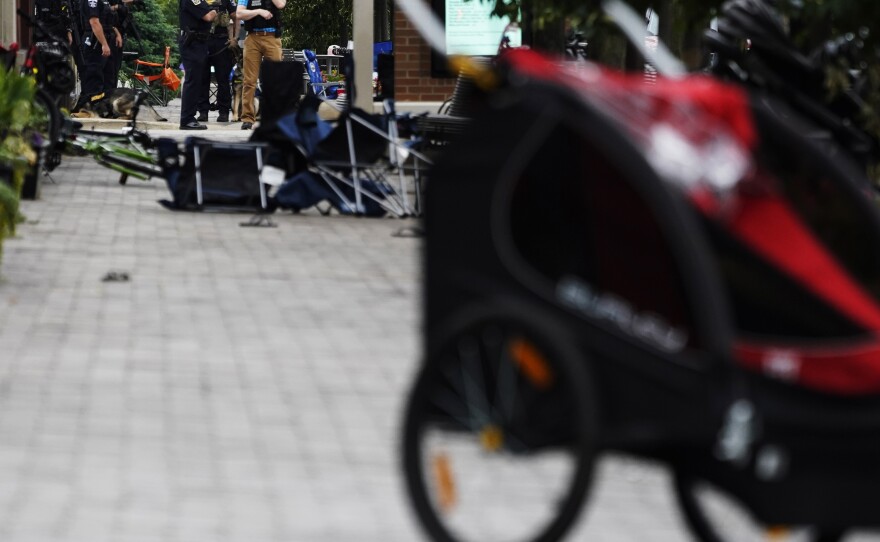Parade attendees in Highland Park were still hiding from the gunshots, looking for their loved ones and cleaning blood off their faces when reactions like this started circulating online:
"Before anyone says anything about this being 'typical for Chicago,' Highland Park is not Chicago," wrote one Twitter user. "Different area, different county, completely different place. Any Chicagoland local will tell you that the north shore is probably the last place we would expect this."
"Similar to saying Shaker Heights ain't Cleveland, and Malibu ain't LA," wrote another. "Highland Park is about the last place you'd expect to find a deranged gunman so well equipped. And THAT is the most terrifying part of the story, perhaps more than the deaths & injuries."
Jessica Beard is a fellow at the Philadelphia Center for Gun Violence Reporting, and said that shock was completely normal in the wake of a shooting like the Highland Park attack. But she raises an eyebrow when comparisons are drawn between areas and populations.
"My guess is that when people say that, they mean we didn't expect this to happen to rich white people in a suburb of Chicago," said Beard, who is also a trauma surgeon at Temple University Hospital. "Firearm violence occurs all over the country. It can happen to people with all different sociodemographic characteristics."
It wasn't the only mass shooting that day
Highland Park's July 4th parade ended in tragedy after a gunman opened fire on the crowd, killing seven people and injuring dozens more. It was one of five mass shootings that took place across the country on Monday.
The Gun Violence Archive reports that one person was killed and 18 injured in shootings in Massachusetts, California, Missouri, Virginia and Chicago. The archive's tracker says that there have already been 314 mass shootings in the U.S. this year.
So what might people mean when they express shock about shootings in specific areas, but not in others?
"A lot of this boils down to which places people are comfortable in," said Rashawn Ray, a fellow at the Brookings Institution, who also heads the Lab for Applied Social Science Research at the University of Maryland. He sees this playing out in the media when the crime statistics of Highland Park are compared to those of nearby Chicago. But Ray said it was also about demographics.
"There are different crime rates in these areas," he said. "But it's also classed and racialized in terms of who is perceived to be potential criminals ... and who are perceived to be potential victims."

He raised similar issues in March when Russia invaded Ukraine.
"There was a series of journalists and media correspondents who were framing and couching their statements — where they would refer to Ukrainians in a particular way that aligns them with Europeans, suggesting that 'these sort of incidents do not happen here,'" he said.
Beard, the trauma surgeon at Temple University Hospital, also sees that parallel when it comes to gun violence in the U.S.
The Gun Violence Archive defines mass shootings as incidents in which a minimum of four victims (excluding the shooter) are shot and either injured or killed. Beard says by that definition, she deals with mass casualties on a near daily basis at her hospital.
"But somebody who's been non-fatally shot in north Philadelphia may never make the news. In fact, half of the people who get shot in Philadelphia never make the news," she said.
What is the media's role?
Journalists need to tell the story of daily gun violence, according to Beard.
In 2021, she led a research study on her hospital's patients who had been treated for gun-related injuries, along with their families and loved ones. She said not one of those people had been interviewed or contacted by a journalist. And seeing the media focus on shootings in other areas, along with the flow of comments that "this shouldn't happen here" and it was "the last place you'd expect," was adding to their trauma. Beard said the implication there was that, because her patients live in north Philadelphia, gun violence was inevitable for them.
"It feels degrading," she said. "And while I think reporting on those events is important, it makes it seem and feel that the folks who are impacted by more common forms of interpersonal gun violence, that their lives don't matter."
Rashawn Ray said that in times of panic and fear, humans sometimes needed to point a finger in order to help them make sense of it all, even if that meant blaming the victims. But that all depends on who they are.
"I think the empathy part is key. See, a lot of us can empathize for what happened in Highland Park," he said. "Whereas you go to the south or west side of Chicago ... people have less empathy because it is blaming the people in that community. Rarely are those same sorts of accusations put on predominantly white areas."
Ray said that communities who felt caught off-guard by violence can resort to the "lone wolf" profile when they're targeted by mass shooters, instead of looking at how one of their own could have turned on them.
"Doing so would suggest that people who live in those neighborhoods, and people in the media who contribute to the narrative, have to take ownership of some of these particular actions," he said. "And people aren't prepared to do that."
Copyright 2022 NPR. To see more, visit https://www.npr.org. 9(MDAzMjM2NDYzMDEyMzc1Njk5NjAxNzY3OQ001))







